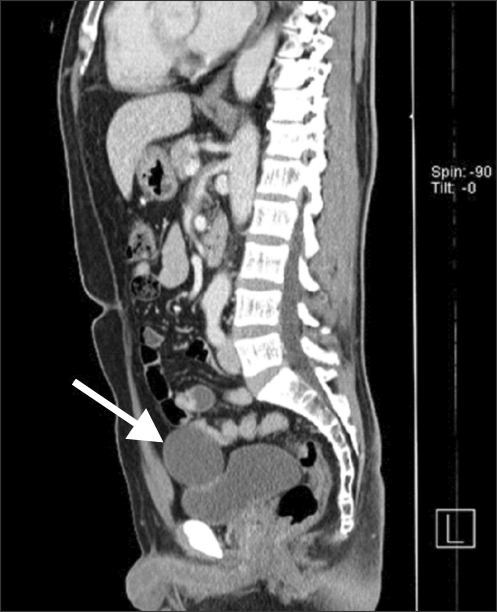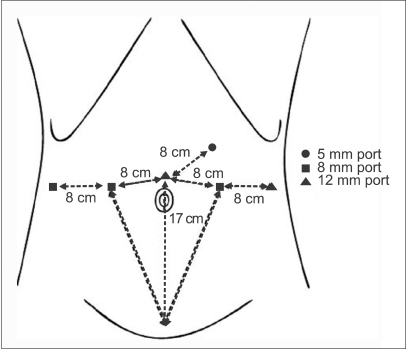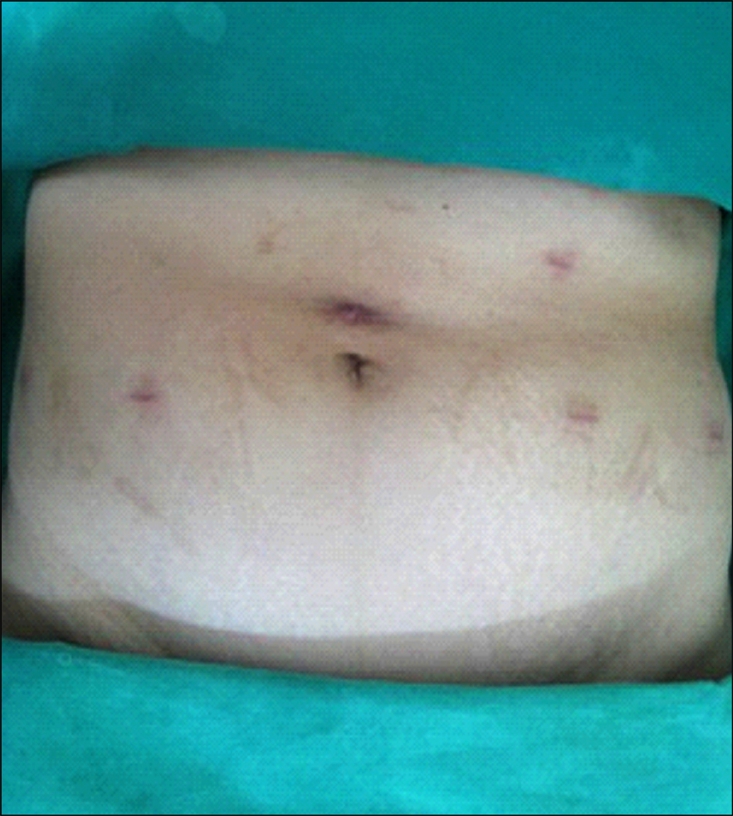Korean J Urol.
2010 May;51(5):318-322.
Initial Experience with Robotic-Assisted Laparoscopic Partial Cystectomy in Urachal Diseases
- Affiliations
-
- 1Department of Urology, College of Medicine, Hanyang University, Seoul, Korea. harabugi@hanyang.ac.kr
Abstract
- PURPOSE
In this study, we report our initial experience with robot-assisted laparoscopic partial cystectomy (RLPC) in urachal diseases. MATERIALS AND METHODS: Two men and two women with a mean age of 51.5+/-9.3 years underwent RLPC between June 2009 and December 2009. In each case, a single surgeon using the da Vinci-S robotic system (Intuitive Surgical, Sunnyvale, CA, USA) used a transperitoneal approach with a 0 degrees robotic camera. After careful observation of the intravesical portion of the mass, the mass was excised by use of monopolar scissors circumferentially. The bladder was closed in two layers with watertight running sutures made with 2-0 Vicryl. RESULTS: The mean operative time was 198 minutes (range, 130-260 minutes), the mean console time was 111 minutes (range, 70-150 minutes), and the mean estimated blood loss was 155 ml. The urethral catheter was removed on postoperative day 7 after a normal cystogram, and the surgical drain was removed on postoperative day 2.5 (range, 2-3 days). The mean hospital stay was 6 days (range, 4-7 days). There were no major complications. The pathology report revealed that one patient had a urachal cystadenoma, two patients had a urachal cyst, and one patient had a patent urachus. CONCLUSIONS: Our initial experience with RLPC for benign urachal disease is that it is a safe and feasible treatment modality. However, more cases are required to confirm the efficacy of RLPC.
Keyword
MeSH Terms
Figure
Reference
-
1. Nieh PT, Marshall FF. Wein AJ, Kavoussi LR, Novick AC, Partin AW, Peters CA, editors. Surgery of bladder cancer. Campbell-Walsh urology. 2007. 9th ed. Philadelphia: Saunders;p. 2503–2505.
Article2. Holzbeierlein JM, Lopez-Corona E, Bochner BH, Herr HW, Donat SM, Russo P, et al. Partial cystectomy: a contemporary review of the Memorial Sloan-Kettering Cancer Center experience and recommendations for patient selection. J Urol. 2004; 172:878–881. PMID: 15310988.
Article3. Kim BH, Kim JH, Park WJ, Ryu DS, Kwon JO, Oh TH. Laparoscopic partial cystectomy for adenocarcinoma of the bladder. Korean J Urol. 2007; 48:990–993.
Article4. Tai HC, Chung SD, Wang SM, Chueh SC, Yu HJ. Laparoscopic partial cystectomy for various bladder pathologies. BJU Int. 2007; 100:382–385. PMID: 17506869.
Article5. Geol H, Kim DW, Kim TH, Seong YK, Cho WY, Kim SD, et al. Laparoscopic partial cystectomy for schwannoma of urinary bladder: case report. J Endourol. 2005; 19:303–306. PMID: 15865518.
Article6. Colombo JR Jr, Desai M, Canes D, Frota R, Haber GP, Moinzadeh A, et al. Laparoscopic partial cystectomy for urachal and bladder cancer. Clinics. 2008; 63:731–734. PMID: 19060992.
Article7. Ficarra V, Cavalleri S, Novara G, Aragona M, Artibani W. Evidence from robot-assisted laparoscopic radical prostatectomy: a systematic review. Eur Urol. 2007; 51:45–55. PMID: 16854519.
Article8. Sala LG, Matsunaga GS, Corica FA, Ornstein DK. Robot-assisted laparoscopic radical cystoprostatectomy and totally intracorporeal ileal neobladder. J Endourol. 2006; 20:233–235. PMID: 16646646.
Article9. Ashley RA, Inman BA, Routh JC, Rohlinger AL, Husmann DA, Kramer SA. Urachal anomalies: a longitudinal study of urachal remnants in children and adults. J Urol. 2007; 178:1615–1618. PMID: 17707039.10. Yiee JH, Garcia N, Baker LA, Barber R, Snodgrass WT, Wilcox DT. A diagnostic algorithm for urachal anomalies. J Pediatric Urol. 2007; 3:500–504.
Article11. Cilento BG Jr, Bauer SB, Retik AB, Peters CA, Atala A. Urachal anomalies: defining the best diagnostic modality. Urology. 1998; 52:120–122. PMID: 9671882.
Article12. Drawson JS, Crisp AJ, Boyd SM, Broderick NJ. Case report: benign urachal neoplasm. Br J Radiol. 1994; 67:1132–1133. PMID: 7820408.
Article13. Park SY, Ham WS, Choi YD, Rha KH. Robot-assisted laparoscopic radical prostatectomy: clinical experience of 200 cases. Korean J Urol. 2008; 49:215–220.14. Rassweiler J, Binder J, Frede T. Robotic and telesurgery: will they change our future? Curr Opin Urol. 2001; 11:309–320. PMID: 11371786.
Article15. Myer EG, Wagner JR. Robotic assisted laparoscopic bladder diverticulectomy. J Urol. 2007; 178:2406–2410. PMID: 17937944.
Article16. Meeks JJ, Hagerty JA, Lindgren BW. Pediatric robotic-assisted laparoscopic bladder diverticulectomy. Urology. 2009; 73:299–301. PMID: 18817959.
Article17. Tareen BU, Mufarrij PW, Godoy G, Stifelman MD. Robot-assisted laparoscopic partial cystectomy and diverticulectomy: initial experience of four cases. J Endourol. 2008; 22:1497–1500. PMID: 18690815.
Article18. Schell AJ, Nickel CJ, Isotalo PA. Complex mucinous cystadenoma of undetermined malignant potential of the urachus. Can Urol Assoc J. 2009; 3:E39–E41. PMID: 19672436.
Article19. Wadhwa P, Kolla SB, Hemal AK. Laparoscopic en bloc partial cystectomy with bilateral pelvic lymphadenectomy for urachal adenocarcinoma. Urology. 2006; 67:837–843. PMID: 16618570.
Article20. Park SY, Cho KS, Park KK, Park SJ, Ham WS, Rha KH. Robot-assisted laparoscopic radical cystectomy with ileal conduit urinary diversion. Korean J Urol. 2008; 49:506–509.
- Full Text Links
- Actions
-
Cited
- CITED
-
- Close
- Share
- Similar articles
-
- Urachal Adenocarcinoma -Report of Two Cases-
- A Case of Urachal Adenocarcinoma of the Urinary Bladder
- Xanthogranulomatous Cystitis Presenting as a Urachal Carcinoma
- Laparoscopic Excision of Complicated Urachal Cyst in Child
- Yonsei Experience in Robotic Urologic Surgery-Application in Various Urological Procedures





